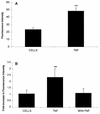Enhancement of lipopolysaccharide-induced neutrophil oxygen radical production by tumor necrosis factor alpha
- PMID: 9529106
- PMCID: PMC108113
- DOI: 10.1128/IAI.66.4.1744-1747.1998
Enhancement of lipopolysaccharide-induced neutrophil oxygen radical production by tumor necrosis factor alpha
Abstract
Although tissues become exposed to both exogenous and endogenous cell-activating mediators during infection, there is little appreciation of the effects of subjecting cells to multiple mediators. We examined the hypothesis that the response of neutrophils to bacterial lipopolysaccharide (LPS) is significantly altered in the presence of the endogenous mediator tumor necrosis factor alpha (TNF). The data showed that human neutrophils pretreated with TNF for 10 to 30 min, displayed significantly enhanced superoxide production in response to LPS (from either Escherichia coli K-235 or E. coli O127:B8), measured as lucigenin-dependent chemiluminescence (CL), seen as an increase in the initial peak rate as well as the total CL accumulated over the incubation period. TNF amplified the response to LPS at 1 to 100 U of TNF/10(6) neutrophils and was able to enhance the response to a wide range of concentrations of LPS (0.01 to 1,000 ng/ml). The TNF-induced increase in the LPS response was paralleled by an increase in LPS binding to the neutrophils, which could be abrogated by an anti-CD14 monoclonal antibody. The results demonstrate that TNF significantly increases the LPS-induced release of oxygen radicals in neutrophils through the upregulation of cell surface CD14.
Figures




Similar articles
-
Interferon-gamma (IFN-gamma) and tumor necrosis factor-alpha (TNF-alpha) enhance lipopolysaccharide binding to neutrophils via CD14.Inflamm Res. 1998 Mar;47(3):101-3. doi: 10.1007/s000110050290. Inflamm Res. 1998. PMID: 9562334
-
Priming of neutrophils by lipopolysaccharide for enhanced release of superoxide. Requirement for plasma but not for tumor necrosis factor-alpha.J Immunol. 1990 Nov 1;145(9):3017-25. J Immunol. 1990. PMID: 2170529
-
Adenosine modulation of tumor necrosis factor-alpha-induced neutrophil activation.Biochem Pharmacol. 1995 Nov 27;50(11):1851-7. doi: 10.1016/0006-2952(95)02078-0. Biochem Pharmacol. 1995. PMID: 8615864
-
Increased surface expression of CD11b/c and CD18 appears to be dissociated from anti-CD11b/c monoclonal antibody stimulated O2- anion generation in in vivo Escherichia coli lipopolysaccharide and tumor necrosis factor-alpha-treated rat neutrophils.Shock. 1994 Oct;2(4):289-95. doi: 10.1097/00024382-199410000-00010. Shock. 1994. PMID: 7757523
-
Characterization of inositol hexakisphosphate (InsP6)-mediated priming in human neutrophils: lack of extracellular [3H]-InsP6 receptors.Br J Pharmacol. 1996 Mar;117(5):979-85. doi: 10.1111/j.1476-5381.1996.tb15291.x. Br J Pharmacol. 1996. PMID: 8851521 Free PMC article.
Cited by
-
Hemoglobin toxicity in experimental bacterial peritonitis is due to production of reactive oxygen species.Clin Diagn Lab Immunol. 1999 Nov;6(6):938-45. doi: 10.1128/CDLI.6.6.938-945.1999. Clin Diagn Lab Immunol. 1999. PMID: 10548590 Free PMC article.
-
The Response of HeLa Cells to Fluorescent NanoDiamond Uptake.Sensors (Basel). 2018 Jan 26;18(2):355. doi: 10.3390/s18020355. Sensors (Basel). 2018. PMID: 29373504 Free PMC article.
-
Zinc ascorbate has superoxide dismutase-like activity and in vitro antimicrobial activity against Staphylococcus aureus and Escherichia coli.Clin Cosmet Investig Dermatol. 2012;5:135-40. doi: 10.2147/CCID.S36214. Epub 2012 Sep 17. Clin Cosmet Investig Dermatol. 2012. PMID: 23055762 Free PMC article.
-
Bacterial lipopolysaccharide and tumor necrosis factor alpha synergistically increase expression of human endothelial adhesion molecules through activation of NF-kappaB and p38 mitogen-activated protein kinase signaling pathways.Infect Immun. 2001 Mar;69(3):1273-9. doi: 10.1128/IAI.69.3.1273-1279.2001. Infect Immun. 2001. PMID: 11179288 Free PMC article.
-
Thrombin-derived host defence peptide modulates neutrophil rolling and migration in vitro and functional response in vivo.Sci Rep. 2017 Sep 11;7(1):11201. doi: 10.1038/s41598-017-11464-x. Sci Rep. 2017. PMID: 28894159 Free PMC article.
References
-
- Beutler B, editor. Tumor necrosis factors, the molecules and their emerging role in medicine. New York, N.Y: Raven Press; 1992.
-
- Dziarski R. Cell-bound albumin is the 70-kDa peptidoglycan-, lipopolysaccharide-, and lipoteichoic acid-binding protein on lymphocytes and macrophages. J Biol Chem. 1994;269:20431–20436. - PubMed
-
- Ferrante A, Kowanko I, Bates E J. Mechanisms of host tissue damage by cytokine-activated neutrophils. In: Coffey R G, editor. Granulocyte responses to cytokines: basic and clinical research. New York, N.Y: Marcel Dekker, Inc.; 1992. pp. 499–521. - PubMed
Publication types
MeSH terms
Substances
LinkOut - more resources
Full Text Sources
Other Literature Sources
Research Materials

